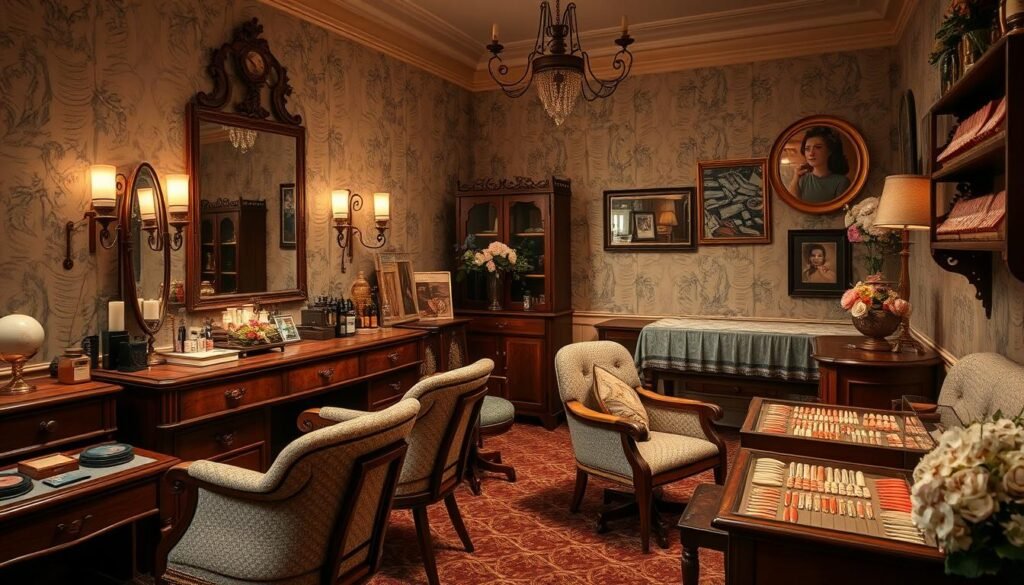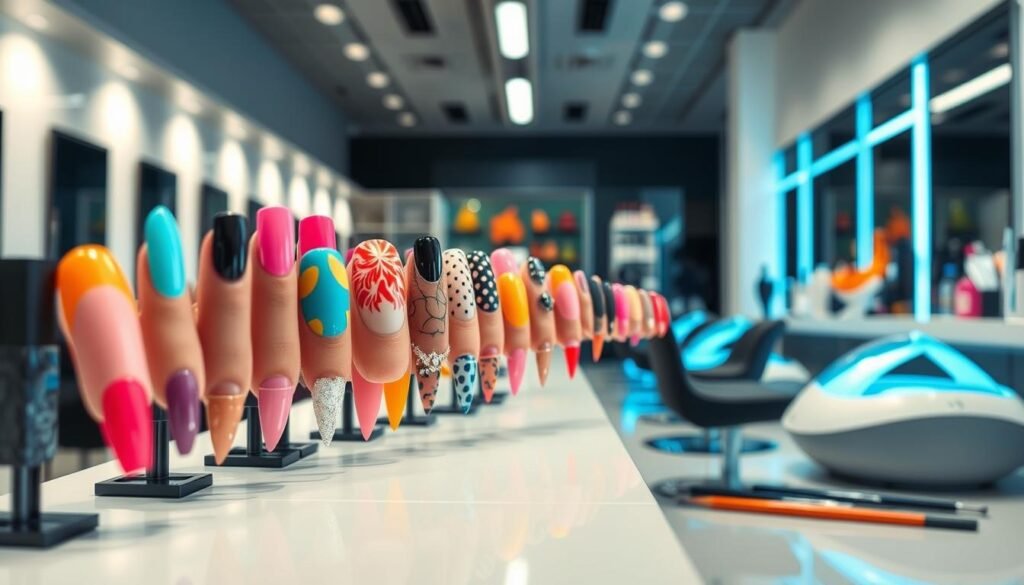Ever wondered about the start of those beautiful, perfectly shaped nails on everyone’s fingers? The history of artificial nails is as interesting as the manicures themselves. It spans from ancient Egypt to today’s salons, filled with innovation, style, and surprises.
Once, only royalty had nail enhancements, showing off their wealth. Now, millions show off their acrylic nails on social media. The tale of artificial nails’ invention and evolution shows our creativity and desire for beauty.
Did you know acrylic nails were found by accident by a dentist? Or that the French manicure, a classic, was made by an American in 1975? These facts are just the beginning of the colorful world of artificial nails.
Exploring who invented nail enhancements, you’ll find out about a dental mistake that changed beauty. You’ll also learn about the risks and the need for safe application. From ancient nobility to today’s Instagram trends, the journey of artificial nails is as varied as the designs on our fingers.
Key Takeaways
- Artificial nails started in ancient Egypt as a status symbol
- A dentist accidentally made modern acrylic nails in 1954
- The artificial nail industry is growing fast worldwide
- Safe application and hygiene are key for nail enhancements
- Social media has greatly influenced nail art trends
- Technology keeps changing the nail industry
The Ancient Origins of Nail Enhancements
The history of artificial nails goes back thousands of years. Early civilizations started what we now call a global beauty trend. From ancient Egypt to China and Greece, nail art showed social status and fashion.
Egyptian Nobility and Artificial Nails
In ancient Egypt, around 2500 BCE, nail color showed who was important. Noblewomen wore artificial nails made of bones or ivory. These nails were not just pretty; they showed wealth and power.
Chinese Nobility and Long Nail Extensions
In China’s Ming Dynasty, around 600 BCE, nail polish became popular. Noblewomen wore long artificial nails to show their status. These nails had fancy designs, starting the nail art journey.
Early 19th Century Greek Fashion Trends
In early 19th century Greece, upper-class women had a unique nail trend. They wore pistachio shells over their nails, starting a European fashion wave. This creative idea helped pave the way for future nail enhancements.
| Era | Location | Nail Enhancement | Significance |
|---|---|---|---|
| 2500 BCE | Ancient Egypt | Bone/Ivory Nails | Status Symbol |
| 600 BCE | China | Long Nail Extensions | Social Standing |
| 19th Century | Greece | Pistachio Shell Nails | Fashion Trend |
These early nail enhancements paved the way for today’s artificial nail industry. It took centuries for a pioneer to make these elite practices available to everyone.
The Birth of Modern Artificial Nails

The modern manicure history started in the late 19th century. This was a new era for nail care. It brought dedicated nail salons and new products that changed the future of artificial nails.
Mary E. Cobb’s Pioneering Manicure Salon
In 1878, Mary E. Cobb opened the first manicure salon in Manhattan. She learned about nail care in France and brought her skills to the U.S. Her salon set the standard for professional nail care, paving the way for others.
The Rise of Nail Care in the 1920s and 1930s
The 1920s and 1930s saw a big increase in nail care popularity. Short, well-manicured nails became a sign of wealth and class. This trend helped lay the groundwork for future artificial nail innovations.
Revlon’s Entry into the Nail Industry
In 1932, Revlon entered the nail industry with a groundbreaking product: long-lasting nail enamel. This was a big step in nail care product evolution. It set the stage for future advancements in artificial nail technology.
| Year | Event | Impact |
|---|---|---|
| 1878 | Mary E. Cobb opens first manicure salon | Established professional nail care standards |
| 1920s-1930s | Rise of short, well-manicured nails | Popularized nail care as a symbol of status |
| 1932 | Revlon introduces long-lasting nail enamel | Advanced nail product technology |
These early 20th-century developments laid the foundation for today’s nail care industry. They sparked a wave of artificial nail innovation. This innovation continues to evolve, shaping the world of nail enhancements we see today.
Who Invented Artificial Nails: The Dental Connection
The story of artificial nails starts in dentistry. In 1954, Dr. Frederick Slack made a groundbreaking discovery.
Dr. Frederick Slack’s Accidental Discovery
Dr. Slack was working on a patient when he cut his thumb nail. He quickly used dental acrylic resin and aluminum foil to fix it. This led to a major breakthrough in nail care.
From Dental Acrylic to Nail Extensions
Dr. Slack was excited by his discovery. He started experimenting with materials. He created a special formula for nail extensions, starting the modern acrylic nail era.
The Birth of Patti Nails Company
Dr. Slack and his brother Tom patented their nails. They started the Patti Nails company. Their invention changed the nail industry, offering a strong and stylish option.
| Year | Event |
|---|---|
| 1954 | Dr. Slack’s accidental discovery |
| 1950s | Experimentation with materials |
| 1970s | Professional use of acrylic nails begins |
Today, acrylic nails are still loved, costing about $45-$55 in Australia. They’ve come a long way from their dental roots. Now, they offer a lasting and versatile way to enhance nails.
Evolution of Artificial Nail Technologies

The journey of artificial nail innovation is truly remarkable. It started with ancient Chinese nobility and has grown a lot since then. Today, the global artificial nails market is worth $1,500 million and is expected to hit $4,500 million by 2032.
Acrylic nails have become a big part of modern manicures. They were first used in the 1950s for artificial teeth. Now, they are thinner and look more natural.
Gel nails arrived in the 1980s, lasting up to two weeks. This change brought a new level of detail to nail art. It also made manicures last longer.
Today, we have products like Glamnetic’s fake nails. They are easy to use at home and are vegan and cruelty-free.
| Nail Type | Introduction | Key Features |
|---|---|---|
| Acrylic | 1950s | Durable, versatile |
| Gel | 1980s | Natural look, long-lasting |
| Glamnetic | Recent | Easy application, ethical |
The future of artificial nails looks bright. New technologies like 3D printing will change nail art. They will make it even more advanced.
Conclusion
The history of artificial nails is truly captivating. It began with ancient Egyptian nobles wearing gold and ivory on their fingers. Today, we have a wide range of nail enhancements.
In the 19th century, Greek women used pistachio shells for nails. This shows how long-lasting the desire for beautiful nails has been.
The 20th century was a big change for artificial nails. Maxwell Lappe got the first patent in 1932. This opened the door for many new ideas.
In the 1970s, Lee Pharmaceuticals introduced press-on nails. This was a major step forward, offering more choices for nail enhancements.
In the 21st century, artificial nails became very popular again. Social media like Instagram and YouTube helped a lot. People could see many different nail styles.
Now, you can pick from many types of nails. There are acrylic nails that last up to 21 days, gel nails for 2-3 weeks, and dip powder nails for a month. The market has something for everyone, with many shapes, colors, and sizes at various prices.
FAQ
Who invented artificial nails?
What were the earliest forms of artificial nails?
What role did Mary E. Cobb play in the history of artificial nails?
How did Revlon contribute to the artificial nail industry?
What types of artificial nails are available today?
How have artificial nail materials evolved over time?
Source Links
- Artificial Nails: a brief history and what to do when they go wrong – Cohen Cramer PI – https://www.cohencramerpi.co.uk/artificial-nails-a-brief-history-and-what-to-do-when-they-go-wrong/
- The Evolution of Acrylic Nails: A Brief History – https://glitterbels.com/blogs/news/the-evolution-of-acrylic-nails-a-brief-history?srsltid=AfmBOoq41gsey3a_7IB9G_80oBr7_ljVcJrkYjL-pXYXokEgkQE9xe8C
- From ancient Egypt to Cardi B: a cultural history of the manicure – https://www.theguardian.com/fashion/2021/jan/27/from-ancient-egypt-to-cardi-b-a-cultural-history-of-the-manicure
- The history of artificial nails: how it all began – https://globalfashion.ru/en/blog/id564-the-history-of-artificial-nails-how-it-all-began
- The Evolution of Acrylic Nails: A Brief History – https://glitterbels.com/blogs/news/the-evolution-of-acrylic-nails-a-brief-history?srsltid=AfmBOoqdQmM6OjFHkIqVfLafIrLCQYKYn1wUwzSd2FSKrR0WruvJnTd5
- The Colorful Journey: Unveiling Nail Art’s Rich History – Lotus Nail Studio – https://lotusnailstudiopgh.com/blog/nail-arts-rich-history/
- Global Fashion – Everything for Beauty Salons and Hairdressers – https://globalfashion.md/en/blog/id496-the-history-of-artificial-nails-how-it-all-began
- Acrylic Nails: How They Became Mainstream – https://thedailyhowl.org/4846/creativity/acrylic-nails-how-they-became-mainstream/
- Artificial nails – https://en.wikipedia.org/wiki/Artificial_nails
- The history of nail art – nail design and nail art how it all began – https://nd24.de/en/pages/die-geschichte-der-nagelkunst-nageldesign-und-nailart-wie-alles-begann
- The History of Nail Care: 1803-2003 – https://www.nailsmag.com/390804/the-history-of-nail-care-1803-2003
- Everything You Need To Know Before Getting Acrylic Nails – https://www.refinery29.com/en-au/acrylic-nails-guide
- The Evolution of Acrylic Nails: A Brief History – https://glitterbels.com/blogs/news/the-evolution-of-acrylic-nails-a-brief-history?srsltid=AfmBOop_-4S8a2s1-M34xuPlEyr70cIsvT47GaMdSrEKYRkoFciFxo_p
- The History and Evolution of Fake Nails in Fashion – https://www.glamnetic.com/blogs/news/history-and-evolution-fake-nails-in-fashion?srsltid=AfmBOooAasNXCwAUwaDJkR_9kBkuEwCsuhJK6kbyRSo1g8Mg06rE62Tj
- Artificial Nail – Quality Hub India – https://qualityhubindia.com/artificial-nail/
- "The Evolution of Press-On Nails: From Practical Origins to Fashion St – https://www.wipup.us/blogs/nails/the-evolution-of-press-on-nails-from-practical-origins-to-fashion-statements








Interesting history, but I reckon aliens taught Egyptians and Chinese about nail extensions. Any thoughts on this quirky theory, folks? #AlienManicureMagic
Quirky indeed! But why stop at nails? Maybe aliens taught us everything! #SarcasmIntended.
Interesting read, but isnt it possible aliens introduced artificial nails to ancient civilizations? They were crazy advanced, after all. Just a theory!
Interesting read, but arent we overlooking the role of the common people in popularizing artificial nails, not just nobility? Just a thought.
Interesting read, but isnt it odd how we applaud artificial nails yet shun other forms of body alteration? Just a thought!
Interesting read, but ever considered that aliens might have given ancient civilizations the idea of artificial nails? Food for thought, huh?
Interesting history, but arent we ignoring the fact that its the common people who popularized artificial nails, not just nobility?
Interesting read, but seriously, were the ancient Egyptians really the first to rock artificial nails or is it just westernized assumptions?
Interesting read, but dont you think aliens might have shared artificial nail tech with ancient civilizations? Just a thought! 🤔👽💅🏼